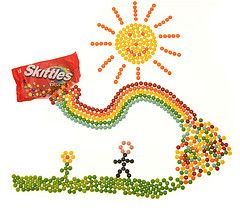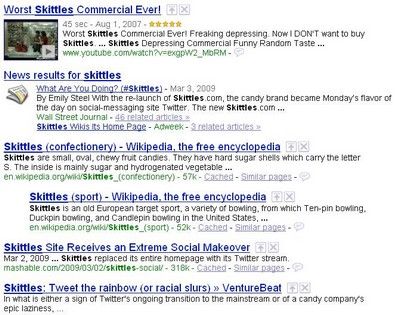“This Blog Post is Not About Skittles”

Nearly everyone defaults to Google when they’re looking for stuff. Sometimes, links to your brand will pop up organically. That’s why you’ll hear the phrase, “Google is your new homepage” as one of the more popular mantras of Social Media zealots.
It’s code for “You’ve lost control.”
Last year, the ad agency Modernista embraced this concept. Their website — as described by David Armano of Logic + Emotion — was “(thrown away) in favor of simply patching together all of their information across various social networks and services.”
This week, Skittles adopted a similar approach. Brian Morrissey of AdWeek wrote a good summation.
But this blog post is not about Skittles.
This blog post is about the embrace of consumer-generated media (CGM) as a primary component of branding. Is it possible? Worthwhile? Too dangerous?
When Doritos started its “Crash the SuperBowl” initiative 3 years ago — sourcing its SuperBowl commercials from consumer creative — it was heralded as a primary example of brands embracing CGM. I beg to differ. While I do laud the approach, it is still very much a “CONTROLLED” initiative. You won’t see any raunchy entries to this contest.
Skittles took it a big step further than Doritos. Modernista may have pioneered the concept of an “uncontrolled” web presence, but Skittles was arguably more bold, since a major brand-name was bound to elicit high volumes of chatter.
And in fact, this approach did burn the Skittles people — as some turdbirds took it on themselves to spam the twitterstream with Skittles-tagged cusswords. In the end, the Twitter hashtag approach was too dangerous. Skittles defaulted to a safe-haven Facebook page as its new “home.” UPDATE: While it is true that the twitterstream got polluted, it was always Skittles’ intention to rotate the homepage across different sites.
Does this mean that embracing CGM as a primary component of branding is a bad idea? Not necessarily. Not at all.
First of all, as noted in the very first paragraph: you don’t really have a choice. The bigger the brand, the more likely that a standard GOOG search will turn up some level of CGM. In fact, I googled “Skittles” yesterday and look what turned up in the first page of results — a keenly negative YouTube video review and a pissy VentureBeat review of their new Social Media-heavy approach:

Just as importantly, look at the potential upsides of CGM. Look at the beautiful, brand-boosting imagery you find at Flickr, when you do a search on the “Skittles” tag:

(This is just one example. Click for more photographic Skittlephilia.)
The fact is that FANS of a brand have far more power to influence its long-term fate than MARKETERS.
Thus the dilemma: how does a brand “relinquish control” to its fans while ensuring some protection from brand-bashers and unruly hooligans?
Partly the answer will come from the community. Maybe if Skittles had allowed its “Twitter hashtag homepage” to continue for another day, they’d find that their fans would have teamed up to shame the hooligans into better behavior?
More likely the answer will come in the form of “curation.” For example, my pal Shannon Whitley, a Social Media Programmer Extraordinaire, tells me that he could pretty easily “present the same real-time information from Twitter Search on a branded, filtered (bad words etc.), moderated (if desired) page.”
The point is, there are ways in which brands can mosey into the CGM patch.
As Social Media grows in importance — as a trend and as a SEO influence — a brand’s curators must make it their mission to HIGHLIGHT and SHARE the best examples of user-created, brand-relevant content… and either engage or ignore the tricksters and haters.
Can you think of some good (or bad) examples of brand curation in the Social Media era? Comment below or “tweet the link” and lemme know?
Continue reading here: If You Only Do *One Thing In Social Media
Was this article helpful?


